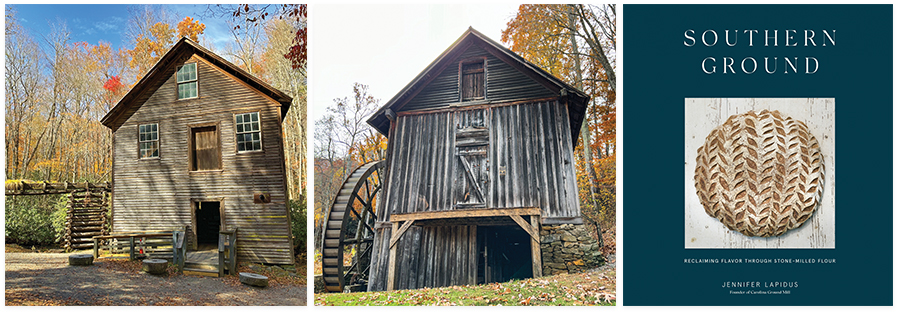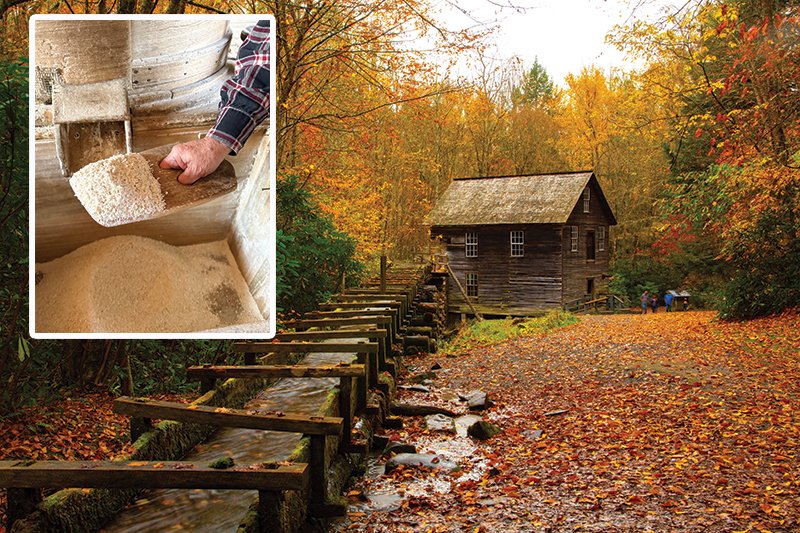Grinding Grains
Grinding Grains: Grist Mills of the Western North Carolina Mountains
No image of mountain heritage is more enduring than a grist mill with a big waterwheel slowly turning by its side. By the mid-1800s every community had at least one grist mill, and some, two or three. Today, only three are still lasting in our region: Mingus Mill in Great Smoky Mountains National Park near Cherokee, Francis Mill in Waynesville, and Carolina Ground in Hendersonville, which is the only mill currently active. Mingus and Francis both date from the 1880s. Carolina Ground is thoroughly modern. It ground its first grain in 2012 and moved to its current location eighteen months ago.
Far beyond their buildings, the mills tell stories that reach deep into mountain family histories; their grindstones, wooden grain hoppers, iron gears, and leather belts evoke far-away—but not forgotten—memories. Even sacks of meal and flour, once toted by mountaineers on horse or muleback to their homes up neighboring creeks, fuel the imagination.
FAMILY BUSINESS
Mingus Mill traces its history back to the family of Jacob and Sarah Mingus, who built the original mill not long after they settled on Oconaluftee Creek in 1808. Their son, Dr. John Mingus, the family patriarch, built the current mill in 1886. Among their descendants was the late Charlie Mingus, iconic jazz musician and composer. His father, Charles Mingus Sr., was the son of Dr. Mingus’s granddaughter and a Black field hand named Daniel. Young Charles Sr. was listed in the 1880 census as a three-year-old white male.
Built in 1887, Francis Mill is only a year younger than Mingus Mill. But from the very beginning, it’s been passed down from grandparent to grandchild—through six generations—to Tanna Timbes. “It gives me cold chills,” she says, “when I think about it.”
“My grandaddy, Dewey Francis, inherited the land from his grandaddy with the stipulation that he couldn’t sell it for twenty-five years. In twenty-five years, you love the land whether you did before or not,” she laughs. “When I was twenty-three, my grandaddy said to me: ‘Tannie, I want you to have this place.’ When you’re twenty-three, you don’t think far ahead,” she maintains. “You don’t think how deep your roots are or what you’re going to care about.”
For forty-four years, Timbes taught school. “When I was ready to retire from teaching school at Bethel Elementary, I looked at the grist mill, and I thought we gotta do something with this place. It’d be a great place for kids to come on field trips,” she remembers. The last time her granddad ground corn in the mill was 1976. It needed a host of repairs. Not knowing how else to find help, Timbes put an ad in the paper. “Thirty-five people showed up. They helped us put jacks under the mill to stabilize it. We fed them lunch and supper for those that stayed,” she remembers. “It took a village to save the mill.”
A MODERN MILL COMMUNITY
Jennifer Lapidus tells a similar story. She depended on “a community effort of crowdfunding, peer lending, grant awards, and empathetic investors” to launch Carolina Ground in Hendersonville in 2012.
Though thoroughly modern, Carolina Ground relies on essentially the same technology deployed in Mingus and Francis Mills for more than 135 years. Though turned by electric motors (Carolina Ground is installing solar panels), wheat and rye are milled by rotating stones, the same as Francis and Mingus Mills.
Carolina Ground operates two mills, a 6,000 pound behemoth wooden Osttiroler from Austria, and a shiny stainless steel New American. Both cold stones grind grain into flour. The similarity between the Osttiroller and the Mingus and Francis Mills couldn’t be clearer. From an inverted wooden pyramidal hopper, grain is fed into a cradle that rocks back and forth, spilling just enough between the turning stones to produce flour of the preferred texture. On the New American, grain is meter fed into the mill, and the tension between stone and grain is displayed in the digital amps reading on its motor.
With both mills, turning a crank determines the gap between the stones. Standing by the mill, Lapidus or her millers can feel and hear the stones’ vibration and scent the air for any tell-tale scorching smell of stone on stone. Mingus miller Rob Gudger puts it this way. “You could be blind and operate a mill,” he continues. “You listen to the stones turnin’. You hear different RPMs. You know it’s runnn’ at the right speed. Too little water or too much corn, and the mill slows down.”
“We use our nose, because if it gets too hot, it’ll smell like popcorn. If it smells too hot, we have to separate the stones a little bit. Stones are separated by a knife blade’s width. If they touched, you’d have grit in the cornmeal and wear the stones down,” he adds.
“Old time millers’ lingo is still in use,” Gudger claims. Remember the saying, “keep your nose to the grindstone,” (meaning keep working hard)? The phrase is rooted in the imperative that millers must keep sniffing all the time to tell if the stones are grinding properly.
And there’s the phrase, “rule of thumb.” Millers can tell how good corn meal is by pinching a bit between thumb and forefinger. Lapidus dabs her finger in freshly ground flour, rubs it onto the inside of her wrist and feels its smoothness. Tim and Tanna Timbes, owners of Francis Mill, grab a handful of the meal they’ve just ground and squeeze it together. “If it stays together,” Tim says, “it’s good.”
GROUNDED IN HERITAGE
Lapidus, Gudger, and the Timbes share lineage going back to the first pioneer families of the late 1700s who, to grind their own corn, built little tub mills on the streams that watered their hardscrabble farms. Neighboring farmers would drop off a few bushels of shucked and dried corn. The miller would grind it into meal or grits as desired, keep a few quarts for his trouble, and allow his customer to pick up the rest. Mills were places where men got together to swap everything from pocket knives to horses, says Gudger. Some mills served as country stores. Under the counter sat jugs of white lightning—whiskey distilled mainly from fermented corn mash.
Though Mingus and Francis once ground wheat and rye, only Carolina Ground does so today. Corn was the mainstay of historic grist mills. Corn will grow anywhere, Gudger says, from stoney hillsides to bottom land rich in humus along rivers. About 1600 years ago, ancestors of the Cherokee began growing corn. With stone mortars and pestles they pounded and ground it into meal. For Cherokee it was a staple, just as it was for early pioneers who settled in the mountains. “They ate corn three times a day,” Gudger says. Boiling cornmeal in water produced thick mush that would keep for days and could be poured on a hot greased iron skillet and fried. Cornbread, of course, was common.
Nobody back then ever put sugar in their cornbread, according to Gudger. For pioneers, store-bought sugar was too precious. If cooks sweetened cornbread at all, “they added a little honey from the bee tree. If you want sweet cornbread, get yourself some Jiffy Mix!” he chuckles.
Powered by a water-turbine, Mingus Mill differs from stereotypical grist mills with waterwheels. Waterwheels are either “overshot” or “undershot” meaning that water diverted from a creek or pond is delivered either over the top or underneath the wheel, causing it to spin vertically. Turbines spin horizontally, catching water beneath the mill. Francis Mill is powered by a typical “overshot” wheel fed by a flume from the pond impounded by the little stream that flows by the mill.
Preserved as working mills, Mingus and Francis demonstrate the role they filled in mountain communities. Due to health department regulations, neither produce cornmeal or grits for sale to the public. Grits and meal for sale at Mingus are cold-stone ground across the Smokies at The Old Mill in Pigeon Forge, TN.
Carolina Ground provides flour to small bakeries throughout the Southeast. A baker at heart, Lapidus is an artist. “Bread wheat has an opalescence,” she says, “while pastry wheat is more opaque.”
“If you look at some grain that looks really good, that’ll be a good indication of the quality.” But how it looks isn’t always reliable. “I’ve had grain from two different fields on the same farm. The sample from one looked awful, the other one great. The one that looked awful, literally, was better.”
“Wheat is incredibly complex,” she believes, “more complex than the human genome.” Agronomists can report chemical and physical characteristics of any batch of grain.” Samples from each load of grain delivered to Carolina Ground are analyzed for mycotoxins, protein, carbohydrates, fats, cellulose, minerals, enzymes, and vitamins.
“We’re not so concerned with grading the wheat for consistency,” she says. The better proof is in the baking. Lapidus test-bakes breads and pastries herself with flour from every delivery of grain to the mill.
Carolina Ground grinds roughly half-a-million pounds of grain a year raised mostly in North Carolina’s Piedmont country. It provides flour to bakeries from as far south as Miami, up to DC, and of course a number of small bakeries here in Western North Carolina, including OWL, Hominy Farm, Beeswax + Butter, and MilkGlass Pie.

More Mill Facts
Mingus Mill (above left) is located in Great Smoky Mountains National Park on US 441, half-a-mile west of the Oconaluftee Visitors Center and Mountain Farm Museum. It is currently closed for repairs to stabilize the mill building and the mill. Just off the Mingus Creek trailhead at the mill’s parking lot is the Enloe Slave Graveyard, where those enslaved by Oconaluftee valley settlers lie buried. nps.gov
Francis Mill (above middle) is located on US 276 about 3 miles east of Waynesville. The Timbes family opens the mill for school and camp groups and stages summer demonstration grinds during events. For more information visit francismill.org.
Carolina Ground (above right) is located in Hendersonville. Jennifer’s beautifully written book, Southern Ground: Reclaiming Flavor through Stone-Milled Flour traces her personal journey from baker to miller and contains scores of tempting recipes. The book is available nationwide and from regional book sellers including Malaprop's Bookstore/Café in Asheville. Carolina Ground hosts monthly pop-up markets in the fall, winter, and spring. For more information about the mill and their pop-up markets, visit carolinaground.com.
